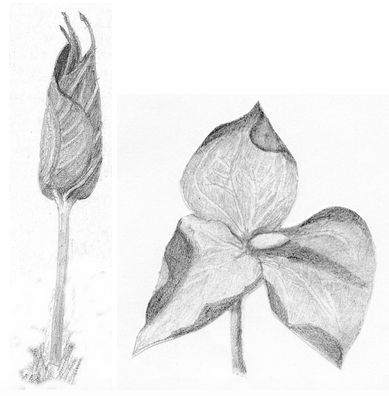Purple Trillium (Trillium erectum)
Reinout Amons
From In Context #17 (Spring, 2007)
During our 11-week spring course in 2006, each student had an independent observation project. Reinout Amons, a retired associate professor of biochemistry in the Netherlands, came to the course with a passion for plants. He decided to do a study of the members of the lily family that grow in the woods neighboring The Nature Institute. Reinout spent many hours following the development of about ten different species in this family. He did drawings and took photographs. Here are some of his observations — presented in words and images — of one species, purple trillium (Trillium erectum).
Starting in early spring, in the first week of April, while most trees still showed their bare wintery appearance, I began studying the emergence and subsequent development of plants belonging to the lily family. I continued observing until the middle of June, when the canopy of the forest trees had reached its maximal expansion. The area observed most thoroughly was a forest across the valley from The Nature Institute. From the banks of the Agawamuck creek, the mixed deciduous forest extends up a slope to the top of Phudd Hill, altogether an area no more than an estimated half a square mile.
The lily family is one of the largest in the plant kingdom. Its number of species is estimated to be at least 3500. Members of the family occur in nearly every part of the world. Most if not all Lily species of the northern temperate zone are perennial herbs, having rhizomes, corms, or bulbs. Interestingly, the genus Trillium only occurs in North America and East Asia, being completely absent in Europe.
Figure 1 (left) and 2.
Figure 3
Phudd Hill is home to one species of trillium, the purple trillium (Trillium erectum). This beautiful plant is found throughout the area, but seems to favor moist soils along the brook and the hill slopes. Its appearance as it unfolds above the ground in mid-April is unique: the vertical, thin stem bears the still enwrapped leaves, which protect the flower bud inside (Figure 1). As the three leaves unfold, the light green flower bud, now nodding sideward, becomes visible (Figure 2). At this stage, it is still impossible to predict what color the flower will have. Within a few days a very conspicuous, surprisingly ill-scented, large flower appears. Each shoot has one flower with three deep, maroon-colored petals (Figures 3 and 4).
Figure 4
The three sepals—originally light green and covering the bud—gradually acquire a purplish lining. The individual flower, unlike many other spring blossoms, lasts quite long (10–14 days), and does not close in overcast weather conditions.
Figure 5
When unfolded, purple trillium has three broad, conspicuously veined leaves issuing from one point on the shoot (that is, they form a whorl) and spreading out in a horizontal plane (Figure 5). Since the plant also has three sepals and three petals, we can understand how it got its Latin name "trillium." Flowers of Lily species, which might greatly vary in shape and color, are nearly always threefold: they either have a fused, six-pointed corolla (as is the case with the Solomon's Seals and the well-known, non-native Lily-of-the-Valley), or, more often, three separate petals and three separate sepals (sometimes mutually very similar and then called tepals), six stamens, and a pistil carrying a style with a threefold stigma. Only the genus Trillium has "threeness" also in its leaves.
When the plant finishes flowering, the sepals and petals dry out and crinkle a bit, but they remain attached to the rest of the flower; the same is true for the six stamens. The sepals even remain green and somewhat fleshy. Moreover, the whole plant continues over many weeks to grow considerably in height and width. So unlike many spring ephemerals, purple trillium holds onto its parts.
Figure 6
Fruit development is quite remarkable in purple trillium. The ovary, which has three major and three minor furrows longitudinally and is colored much like the petals, now rapidly expands (Figure 6). I made cross sections of the developing fruit, which shows an expected threefold symmetry internally and contains numerous seeds in a juicy ‘pulp' (Figure 6 bottom). The fruit development takes a couple of months, continuing till fall. The seeds, having a so-called elaiosome, attracting ants, are described as needing two winter periods before they germinate.
References
Lamoureux , Gisèle (2002). Flore printanière. (Only available in French.) Saint-Henry-de-Lévis: Fleurbec.
Newcomb, Lawrence (1977). Newcomb's Wildflower Guide. New York: Little, Brown and Company.
Natural Resources Conservation Service: http://plants.usda.gov
Flora of North America: http://hua.huh.harvard.edu/FNA





